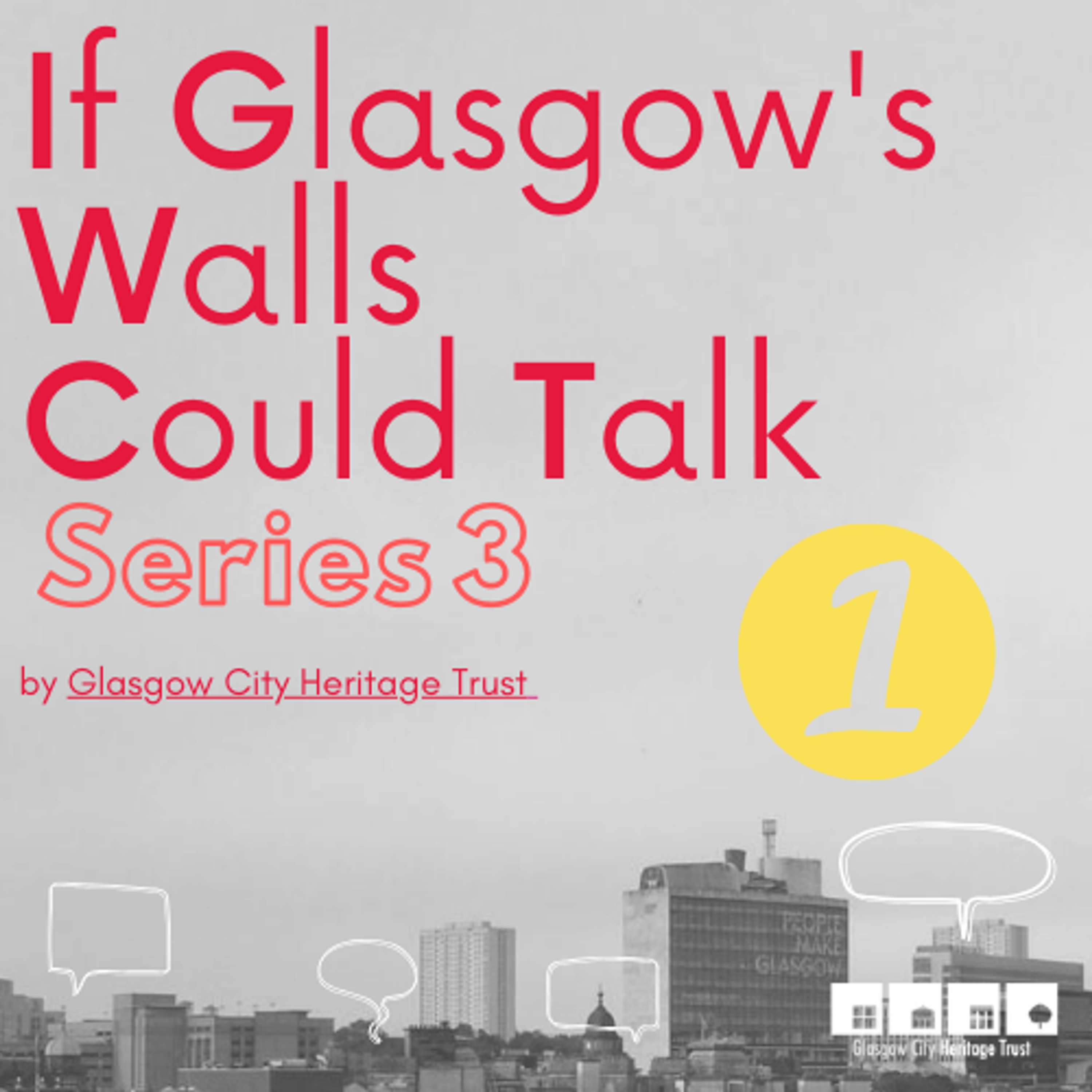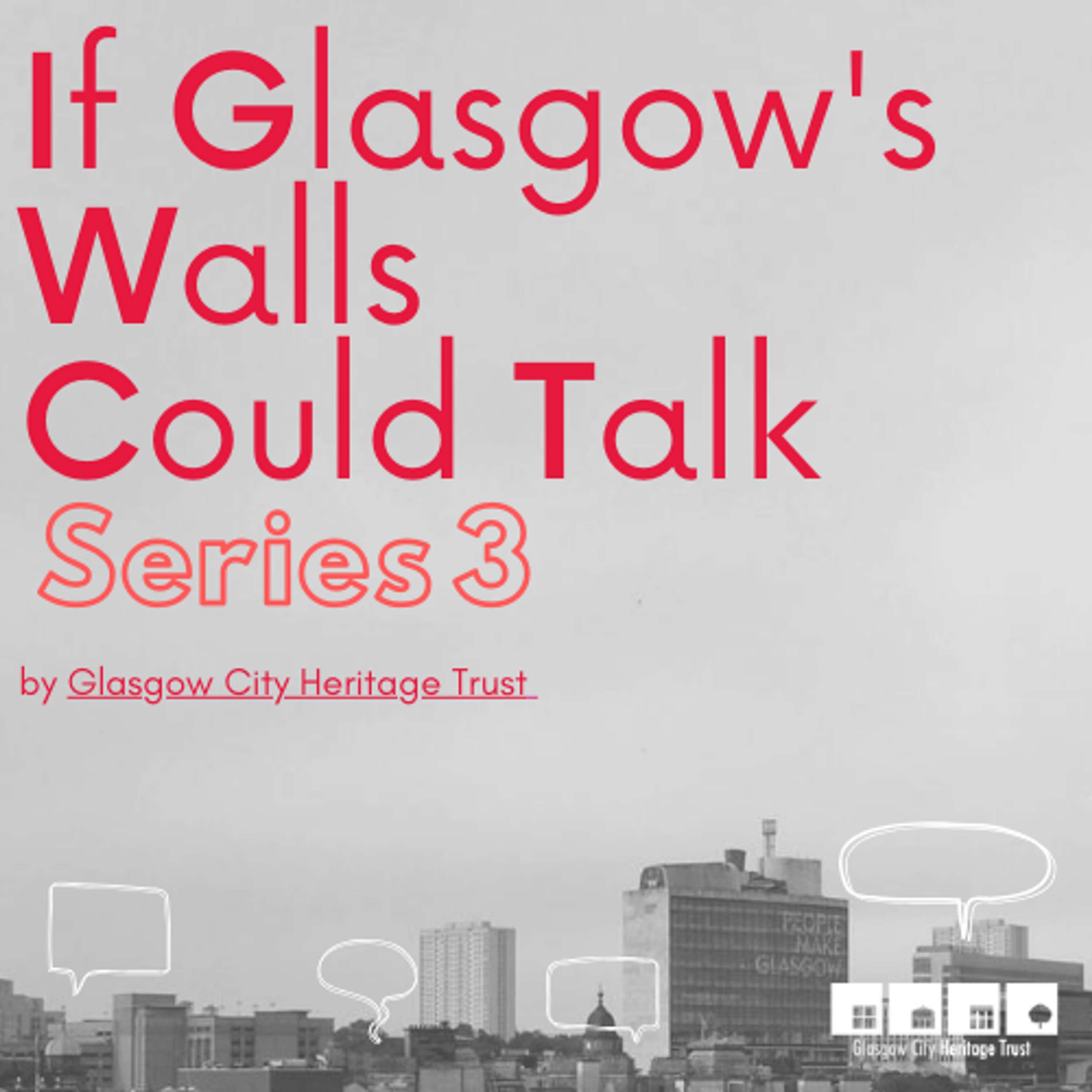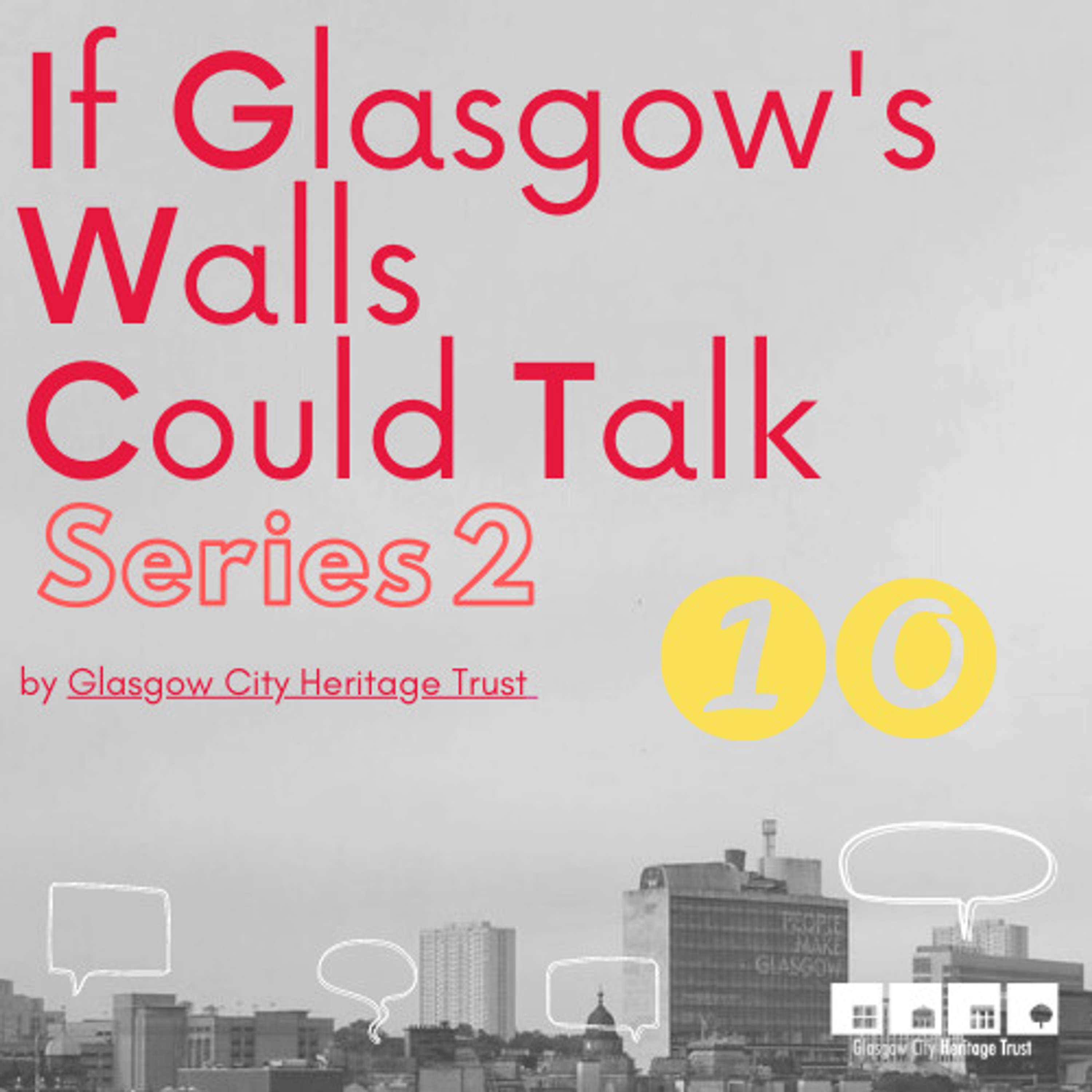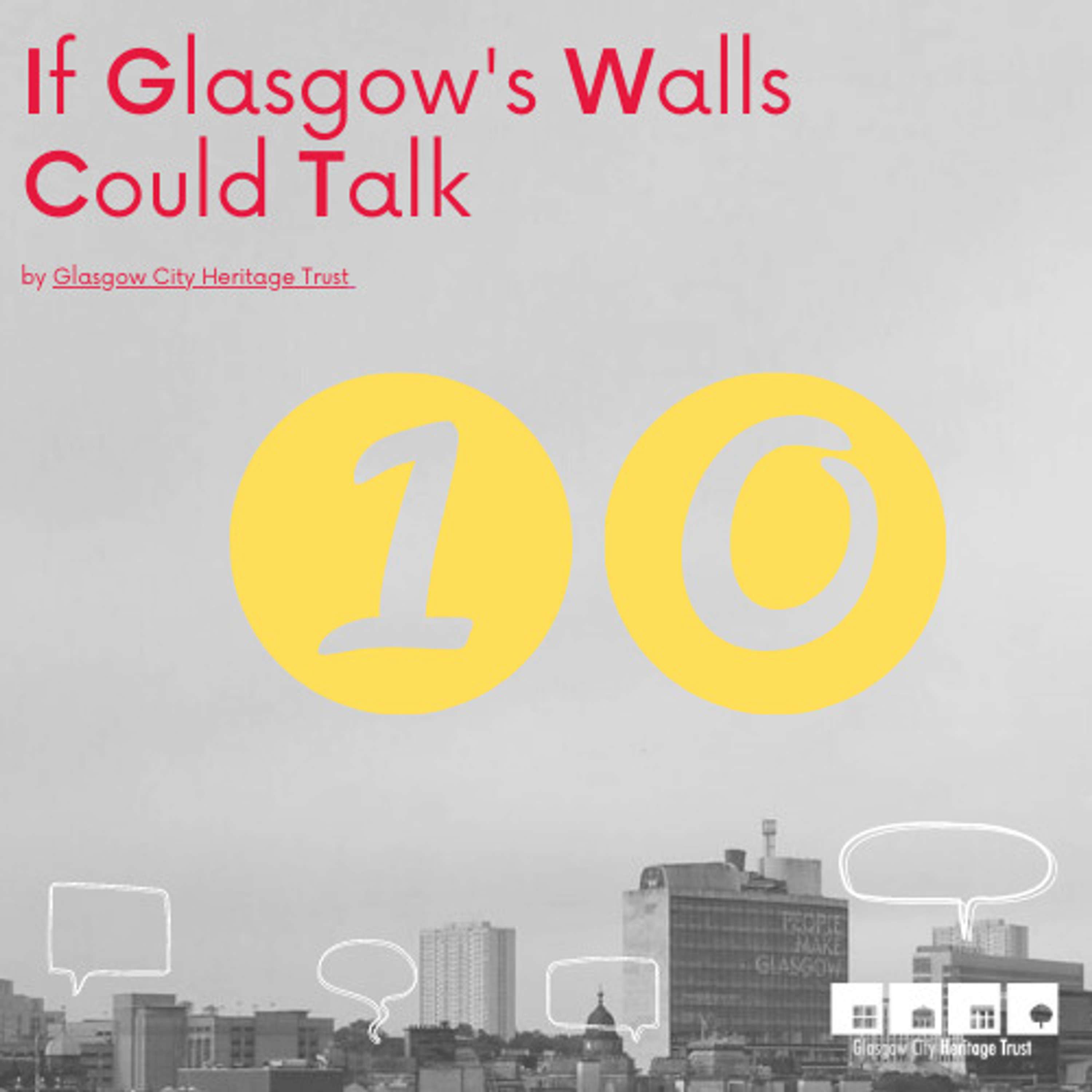Discover If Glasgow’s Walls Could Talk
If Glasgow’s Walls Could Talk

If Glasgow’s Walls Could Talk
Author: Glasgow City Heritage Trust
Subscribed: 24Played: 210Subscribe
Share
© Glasgow City Heritage Trust
Description
A podcast by Glasgow City Heritage Trust which focuses on the relationships, stories and shared memories that exist between Glasgow’s historic buildings and the city's communities. Presented by Glasgow City Heritage Trust’s Director Niall Murphy and journalist Fay Young, this series features guests discussing with Niall and Fay a specific area, type of building or aspect of Glasgow’s heritage, not only from a historical and architectural point of view, but also from the perspective of the community; drawing on the guests’ personal experiences, thoughts, knowledge and memories.
23 Episodes
Reverse
How often do you rush through Glasgow Central Station without a second glance? Never again! Join us on a live, on-location tour with guide Jackie Ogilvie. Discover the station's fascinating history, hidden architectural details and a behind-the-scenes look at the successful Glasgow Central Station tours. Plus, learn about Jackie's exciting museum project in the works.Highlights:Live tour experience with guide Jackie OgilvieUnveiling the hidden history and architecture of Glasgow Central StationExploring the popular Glasgow Central Station toursExclusive scoop on Jackie's upcoming museum projectKey Moments:00:00:01 — The stories underneath00:32:00 — Welcome to the Museum00:53:00 — WWI Memorial Art Installation01:05:00 — The Victorian Platform01:15:00 — Central Station’s evolutionLearn more:Visit https://www.glasgowcentraltours.co.uk/index.aspx for more information on Glasgow Central Station tours.Follow Glasgow City Heritage Trust on social media: @GlasgowHeritage #IfGlasgowsWallsCouldTalkProduced by Inner Ear (innerear.co.uk) for Glasgow City Heritage TrustSponsored by Tunnock's (tunnock.co.uk)
Get Ready to Hear Glasgow's Secrets! Series 3 of If Glasgow's Walls Could Talk Arrives 27th June!We're thrilled to announce the return of If Glasgow's Walls Could Talk for a brand new series, premiering on 27th June, 2024.This series digs deeper, unearthing the wealth of human history built into the city, often giving voice to people whose story has not been told before.Stay Tuned!Visit our website for updates: https://www.glasgowheritage.org.uk/Follow us on social media: @GlasgowHeritageJoin the conversation: #IfGlasgowsWallsCouldTalkProduction & SponsorsProduced by Inner Ear for Glasgow City Heritage TrustKindly sponsored by Tunnock's
Have you wondered what Niall's favourite building in Glasgow is? Well this week you can find out! The tables are turned on Niall as his good friend Norry finds out about how he ended up at GCHT and any lessons he's learned from the podcast.Norry Wilson is a well known figure in Glasgow, having set up Lost Glasgow in 2012. Norry is a journalist and social historian with a lifelong fascination with his home city, Glasgow. His Lost Glasgow Facebook page and Twitter accounts, with their mix of archive images and stories relating to Glasgow’s history, have amassed a huge following over the years. This conversation was recorded on 16th March 2023.Keep an eye on our website glasgowheritage.org.uk, join us on social media @GlasgowHeritage and follow #IfGlasgowsWallsCouldTalkThis podcast was produced by Inner Ear for Glasgow City Heritage Trust. It is kindly sponsored by the National Trust for Scotland and supported by Tunnock’s.
In our penultimate episode of the Series Niall and conservation architect Fiona Sinclair take a metaphorical walk through Glasgow's many parks and green spaces. They talk about the Victorians who planned these spaces for citizens to enjoy more than a hundred and fifty years ago, how they have changed over time, and how they've been used, with a stop at some of the well known glasshouses along the way. This conversation was recorded on 9th February 2023. Keep an eye on our website glasgowheritage.org.uk, join us on social media @GlasgowHeritage and follow #IfGlasgowsWallsCouldTalkThis podcast was produced by Inner Ear for Glasgow City Heritage Trust. It is kindly sponsored by the National Trust for Scotland and supported by Tunnock’s.
We're joined by Gabrielle Macbeth, Volunteer Coordinator at Glasgow Women's Library and Anabel Marsh, one of the Library's longest serving volunteers who tell Niall about their pioneering walking tours which started in 2007. We hear how the staff and volunteers have worked tirelessly to highlight women's diverse but often unrecognised impact on the city of Glasgow. This conversation was recorded on 2 March 2023. Keep an eye on our website glasgowheritage.org.uk, join us on social media @GlasgowHeritage and follow #IfGlasgowsWallsCouldTalkThis podcast was produced by Inner Ear for Glasgow City Heritage Trust. It is kindly sponsored by the National Trust for Scotland and supported by Tunnock’s.
In our first ever live podcast recording we’re joined by Dr Hilary Wilson and Dr Kate Stevens from Friends of Glasgow Royal Infirmary to hear about the history of the development of Glasgow Royal Infirmary, the many pioneering healthcare providers that worked at Glasgow Royal Infirmary, and their experiences setting up the recently opened museum in the Royal Infirmary. This conversation was recorded in front of a live audience in the museum at Glasgow Royal Infirmary on 24th August 2022.Keep an eye on our website glasgowheritage.org.uk, join us on social media @GlasgowHeritage and follow #IfGlasgowsWallsCouldTalkThis podcast was produced by Inner Ear for Glasgow City Heritage Trust. It is kindly sponsored by the National Trust for Scotland and supported by Tunnock’s.
Joey and Niall discuss the newly formed Glasgow Housing Struggle Archive and how it informs and is informed by Glasgow's strong connection to housing struggles and movements throughout history. Joey tells us about the Archive, what its aims are and how he envisions it evolving. He also chats with Niall about the tradition of rent strikes, occupations and protest that continues up to today.Joey is a writer and artist from Glasgow. He is co-founder of the Glasgow Housing Struggle Archive, a member of the National Committee of Living Rent – Scotland’s tenants’ union. He is currently working on a number of projects with the CCA, Platform, Glasgow Sculpture Studios, Edwin Morgan Trust and the Travelling Gallery.This conversation was recorded on 23rd February 2023.Keep an eye on our website glasgowheritage.org.uk, join us on social media @GlasgowHeritage and follow #IfGlasgowsWallsCouldTalkThis podcast was produced by Inner Ear for Glasgow City Heritage Trust. It is kindly sponsored by the National Trust for Scotland and supported by Tunnock’s.
Whilst Glasgow may not be as famous as Edinburgh for it’s ghosts and ghouls, there are still stories of many spooky goings on around the city. Join Jan Murdoch Richards from Lanarkshire Paranormal to hear about their investigations in and around Glasgow. This conversation was recorded on 11th August 2022.Keep an eye on our website glasgowheritage.org.uk, join us on social media @GlasgowHeritage and follow #IfGlasgowsWallsCouldTalkThis podcast was produced by Inner Ear for Glasgow City Heritage Trust. It is kindly sponsored by the National Trust for Scotland and supported by Tunnock’s.
Glasgow is home to the largest concentration of showpeople in Europe, but they go largely unnoticed in the city until planning issues come to light. In this episode Niall and Dr Mitch Miller discuss the long history of showpeople and their yards in Glasgow, how they have changed and developed over the years, and the current threats to their spaces.Dr Miller is a social researcher, artist, and cultural activist who comes from a showpeople family. Over the last couple of decades Mitch has become a pioneering presence in Glasgow through his activism. He is perhaps most known for inventing the dialectogram, a piece of graphic art that depicts place from the ground up in collaboration with communities. This conversation was recorded on 24th January 2023.Keep an eye on our website glasgowheritage.org.uk, join us on social media @GlasgowHeritage and follow #IfGlasgowsWallsCouldTalkThis podcast was produced by Inner Ear for Glasgow City Heritage Trust. It is kindly sponsored by the National Trust for Scotland and supported by Tunnock’s.
Alasdair Gray’s iconic work is dotted around the city of Glasgow, but how did the city impact his life and work? This week we’re joined by Sorcha Dallas, Custodian of The Alasdair Gray Archive to discuss all things Alasdair Gray. Sorcha met Gray in 2007 and became Custodian of the archive following his death in 2019. The archive holds a large collection of of Gray's work which includes sketches, drawings and original prints, as well as a a re-staging of his working studio set up.This conversation was recorded on 2nd February 2023.Keep an eye on our website glasgowheritage.org.uk, join us on social media @GlasgowHeritage and follow #IfGlasgowsWallsCouldTalkThis podcast was produced by Inner Ear for Glasgow City Heritage Trust. It is kindly sponsored by the National Trust for Scotland and supported by Tunnock’s.
This week we’re joined by photographer Chris Leslie, who began his career in the Balkans in the 1990s. His 2017 book and multimedia project ‘Disappearing Glasgow’ featured photographs, essays and interviews with people from areas in Glasgow which have dramatically changed in the last ten years including Dalmarnock and the Red Road flats. Niall and Chris discuss the changes that they have seen across the city and the impact this has had on the people that live there. Find out more about Chris’ new book ‘Balkan Journey’ here: https://www.balkanjourney.com/the-book/ This conversation was recorded on 2nd August 2022.Keep an eye on our website glasgowheritage.org.uk, join us on social media @GlasgowHeritage and follow #IfGlasgowsWallsCouldTalkThis podcast was produced by Inner Ear for Glasgow City Heritage Trust. It is kindly sponsored by the National Trust for Scotland and supported by Tunnock’s.
In our first episode of Series 2 we welcome Dr Emily Munro, Curator and Learning Officer at the National Library of Scotland’s Moving Imagine Archive for an enlightening discussion about Glasgow on film. The Moving Image Archive is Scotland's national collection of moving image and is based in Kelvin Hall in the West End of Glasgow, where they care for 46,000 items. Dr Munro and Niall discuss film makers in and around Glasgow, and the great change that the city has seen over the last 100 years - but also some of the continuities. They also chat about some of the ‘hidden gems’ of the Moving Image Archive and what’s next for the Archive. Some of the films discussed:- Great Glasgow Fires https://movingimage-onsite.nls.uk/film/1733 - Glasgow School of Art in 1950s https://movingimage.nls.uk/film/3352 - Eddie McConnell & Oscar Marzaroli later shot this Murray Grigor d. film about Mackintosh https://movingimage.nls.uk/film/2226- Faces, 1959, d. Eddie McConnell https://movingimage.nls.uk/film/1942- Our Transport Services, made by the Glasgow Corporation, 1949, https://movingimage.nls.uk/film/0057 - St Enoch Hotel and Station, 1966, https://movingimage.nls.uk/film/4004- KH-4, starring Bill Forsyth, 1960s, https://movingimage.nls.uk/film/3631 - Mungo’s Medals, 1961, Glasgow Corporation film about new housing developments, https://movingimage.nls.uk/film/2102 - Demolition of Grand Hotel Charing Cross https://movingimage.nls.uk/film/2699 (onsite only)- The Planner’s Approach, https://movingimage.nls.uk/film/4196 (onsite only) - Battle of the Styles, 1968, https://movingimage.nls.uk/film/2319- The Lamplighter, 1956, https://movingimage.nls.uk/film/1500- Glasgow Gets to Work, 1935, https://movingimage.nls.uk/film/3246 Additional films:- Spot the Spot, 1926, a quiz made for cinema patrons, https://movingimage.nls.uk/film/0863C - Shieldhall Chemical Sundries Department, 1959, manufacturing everything from custard and jelly crystals to asprin and shoe polish https://movingimage.nls.uk/film/0616 - Glasgow Takes Care of Its Old Folk, 1949, Innovative Glasgow Corporation ‘cottage’ housing development, designed to provide accommodation for the elderly and to keep elderly couples together https://movingimage.nls.uk/film/0135 - Tribute to Wartime Production, 1941, King George VI and Queen Elizabeth tour Templeton's carpet factory in Glasgow where women are making army blankets, https://movingimage.nls.uk/film/1625This conversation was recorded on 22nd November 2022.Keep an eye on our website glasgowheritage.org.uk, join us on social media @GlasgowHeritage and follow #IfGlasgowsWallsCouldTalkThis podcast was produced by Inner Ear for Glasgow City Heritage Trust. It is kindly sponsored by the National Trust for Scotland and supported by Tunnock’s.
Across the 19th and 20th centuries, Glasgow was home to a huge number of music halls, theatres, and cinemas, which served and entertained the population. These spaces occupied a significant role in the social and architectural life of the city and in people’s memories, and many still do.Join us for a double guest episode about the entertainment industry of the past, with a focus on historic music halls, theatres, and historic cinemas with Judith Bowers, Founder and Director of the Britannia Panopticon Music Hall campaign and Gary Painter, co-founder of the Scottish Cinemas Project.Keep an eye on our website glasgowheritage.org.uk, join us on social media @GlasgowHeritage and follow #IfGlasgowsWallsCouldTalkThis podcast was produced by Inner Ear for Glasgow City Heritage Trust.This podcast is kindly sponsored by the National Trust for Scotland and supported by Tunnock’s.
People and social interactions are at the heart of football, just like stadiums and other venues linked to a specific sport, such as pubs and clubs.Football Memories Scotland is a project which provides opportunities for people with Alzheimer’s disease or dementia to reminisce through discussion of archive football images. The Scottish football archive at the Scottish Football Museum holds thousands of images covering the history of the game in Scotland. These images are used as memory triggers for participants and can assist with short term memory recall.This episode’s guest is Robert Harvey, Volunteer and Area Co-ordinator for Glasgow, Football Memories Scotland.Keep an eye on our website glasgowheritage.org.uk, join us on social media @GlasgowHeritage and follow #IfGlasgowsWallsCouldTalkThis podcast was produced by Inner Ear for Glasgow City Heritage Trust.This podcast is kindly sponsored by the National Trust for Scotland and supported by Tunnock’s.
Have you ever wondered why there are so many historic school buildings in our city?The high number of old schools in Glasgow relates to the Education Scotland Act of 1872, which made elementary education compulsory and free for all children between the ages of 5 and 13. In Glasgow alone, 75 new schools were built between 1873 and 1918.The cost, upkeep and preservation of these massive Victorian and Edwardian School Board buildings has been a constant challenge for the council, the pupils and teachers and the larger school communities.So what can community’s do to save these buildings? Are they salvageable? Are they even worth saving? In this episode we focus on a great example of a community taking ownership and repurposing a historic school building. The Kinning Park Complex is an independent multi use community space in the Southside of Glasgow, located in an old red sandstone building and originally built in 1916 as an annex to the Lambhill Street Primary School. Martin Avila, former Director of Kinning Park Complex, talks about the challenges and the joys of community ownership.Keep an eye on our website glasgowheritage.org.uk, join us on social media @GlasgowHeritage and follow #IfGlasgowsWallsCouldTalkThis podcast was produced by Inner Ear for Glasgow City Heritage Trust.This podcast is kindly sponsored by the National Trust for Scotland and supported by Tunnock’s.
During the last decade, mural painting has flourished in Glasgow, and they can be found all over the city, covering a huge range of topics from saints’ lives to flying taxis, pelicans, swimmers and poems.The Glasgow City Council’s Mural Fund is a scheme which offers support towards the costs involved in creating and delivering new murals in the city centre.In this episode we discuss how Glasgow’s murals enrich the urban landscape and the process behind their creation with John Foster, Project Lead for the City Centre Mural Trail and Ali Smith, Director of Art Pistol projects, the company behind some of the most iconic murals in the city.Keep an eye on our website glasgowheritage.org.uk, join us on social media @GlasgowHeritage and follow #IfGlasgowsWallsCouldTalkThis podcast was produced by Inner Ear for Glasgow City Heritage Trust.This podcast is kindly sponsored by the National Trust for Scotland and supported by Tunnock’s.
Glasgow is famous for its stunning historic buildings dating from the 18th, 19th and early 20th centuries, when the city was known as the Second City of the Empire.Unfortunately, a lot of these heritage spaces are inaccessible to many people living, working and visiting Glasgow. Barriers are at the root of disabled people’s exclusion and are an obstacle to their enjoyment and appreciation of heritage, culture and art.In Scotland, one in five people are disabled. Only 8% of Scottish people with disabilities are wheelchair users, and 70% have disabilities which are invisible. (Visit Scotland 2021 Survey, 2021). Access needs are as unique and individual as the person who requires them.In this episode we talk about accessibility, representation and inclusivity in heritage spaces with Accessibility Consultant Emily Rose Yates.Keep an eye on our website glasgowheritage.org.uk, join us on social media @GlasgowHeritage and follow #IfGlasgowsWallsCouldTalkThis podcast was produced by Inner Ear for Glasgow City Heritage Trust.This podcast is kindly sponsored by the National Trust for Scotland and supported by Tunnock’s.
From the 1700s until the UK abolished slavery in 1833, many Glasgow merchants made their fortune from trading tobacco, sugar, rum and cotton produced by enslaved people on plantations or in factories.Historians have recorded 19 slave voyages leaving Greenock and Port Glasgow in the six decades between 1706 and 1766, carrying roughly 3000 people into slavery. Many historic buildings and areas in Glasgow are linked with these trades.In this episode we talk to Glasgow’s Gallery of Modern Art (GoMA) Curator Katie Bruce about the different ways in which this aspect of Glasgow’s history can be researched, interpreted and highlighted, with a special focus on the GoMA building and its convoluted history.Keep an eye on our website glasgowheritage.org.uk, join us on social media @GlasgowHeritage and follow #IfGlasgowsWallsCouldTalkThis podcast was produced by Inner Ear for Glasgow City Heritage Trust.This podcast is kindly sponsored by the National Trust for Scotland and supported by Tunnock’s.
This double guest episode is about the history of tenements in Glasgow and what it is like to live in a tenement now compared to living in one at the start of the 20th Century.Living in a tenement is extremely common in Glasgow, as stone tenements have been part of the fabric of our city since the 19th century. According to recent research, around 73% of Glaswegians live in a tenement of some sort!Tenements were first built during the industrial revolution to accommodate large numbers of people moving to the city to work. At this time, Glasgow’s population grew from a quarter of a million at the start of Queen Victoria’s reign to 760,000 at the end of it.In this episode we will be discussing tenement living in the past with Ana Sánchez-De La Vega, Visitor Service Supervisor at the Tenement House (NTS) and tenements as communities now with Allistair Burt, who owns a flat at Camphill Gate, a B-Listed tenement on Glasgow’s Southside.Keep an eye on our website glasgowheritage.org.uk, join us on social media @GlasgowHeritage and follow #IfGlasgowsWallsCouldTalkThis podcast was produced by Inner Ear for Glasgow City Heritage Trust.This podcast is kindly sponsored by the National Trust for Scotland and supported by Tunnock’s.
In this episode we talk about Scottish LGBTQ+ history and places, and how queer stories are researched and interpreted.Today, LGBTQ+ people in Scotland can marry, adopt children and pursue wonderful careers. Political leaders and public figures can openly identify as gay or bisexual, and Scotland recently topped two European league tables measuring legal protections offered to LGBTQ+ people. But this is all very recent, and Scotland only decriminalised gay sex between consenting men in 1980.Queer spaces such as bars, pubs, bookshops, squares and parks therefore play a very important role in queer history. But how can we research and collect queer stories and what sort of traces did past queer people leave behind?We explore this topic with Dr. Jeffrey Meek, Lecturer in Economic and Social History at Glasgow University and Founder and Curator of QueerScotland, a fascinating website and research tool showcasing historical maps of queer places and spaces in Glasgow, Edinburgh, Aberdeen, Dundee and across the wider Central Belt.Keep an eye on our website glasgowheritage.org.uk, join us on social media @GlasgowHeritage and follow #IfGlasgowsWallsCouldTalkThis podcast was produced by Inner Ear for Glasgow City Heritage Trust.This podcast is kindly sponsored by the National Trust for Scotland and supported by Tunnock’s.
Comments
 United States
United States






















